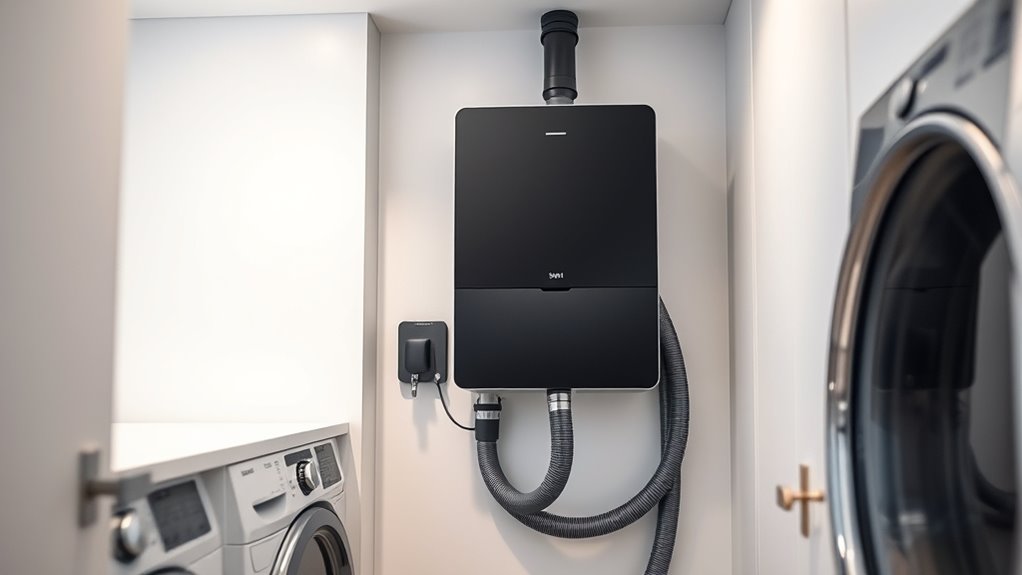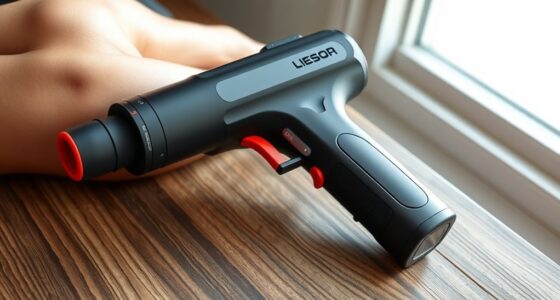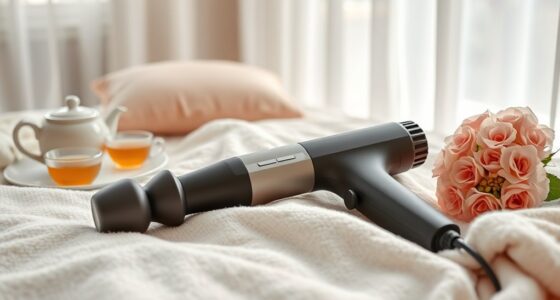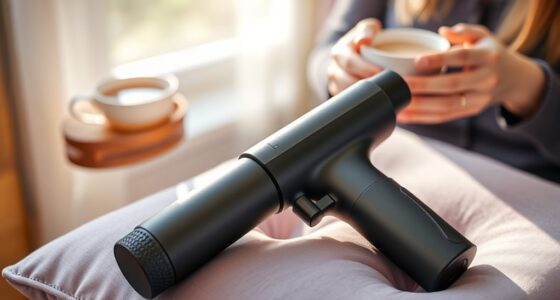If you’re searching for the quietest central vacuum systems in 2023, I’ve found top models like the OVO Heavy Duty units, Prolux CV12000, and systems with noise-reducing features that operate at around 70 dB. These models combine powerful suction with advanced sound insulation, making them perfect for noise-sensitive homes. They also offer high capacity and durability for extensive cleaning needs. Keep exploring to discover more about these efficient, silent vacuum solutions that can transform your cleaning experience.
Key Takeaways
- Many models feature noise-reducing mufflers and foam insulation to operate at around 70 dB for quiet cleaning.
- High-efficiency soundproof housings and vibration-dampening technologies minimize operational noise without sacrificing performance.
- Advanced motor designs like brushless and soft start/stop motors significantly lower noise levels during use.
- Large-capacity canisters and external mufflers help reduce noise and support prolonged, quiet cleaning sessions.
- Proper placement, sound barriers, and insulation enhance overall home comfort during vacuuming in residential settings.
OVO Heavy Duty Central Vacuum System with 40ft Accessory Kit
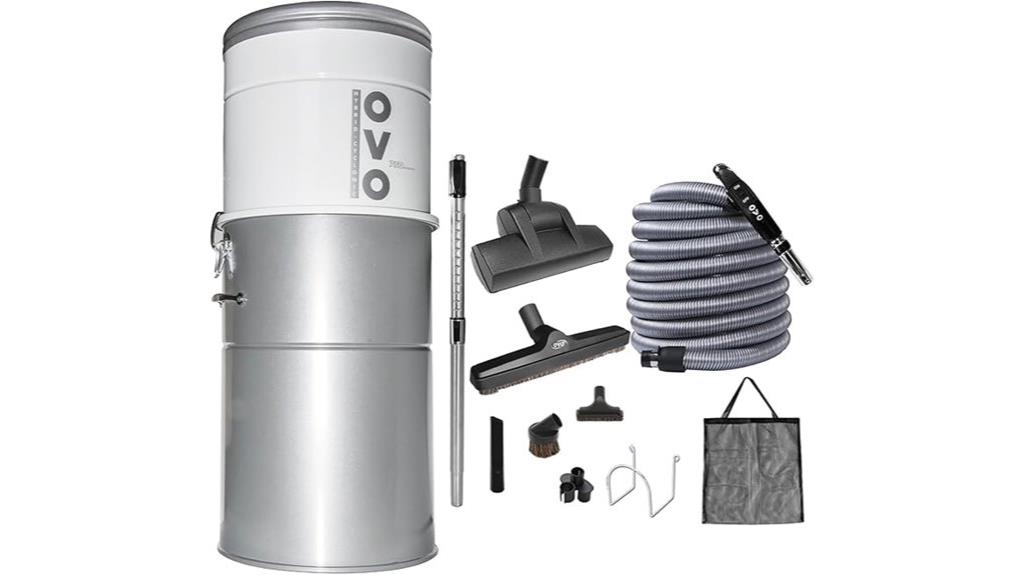
If you’re looking for a powerful, durable central vacuum system that can handle large spaces with ease, the OVO Heavy Duty Central Vacuum System is an excellent choice. It delivers 750 Airwatts of power, thanks to a 2-stage Ametek USA motor producing 140.2 CFM airflow. The system includes a 40ft low-voltage hose and turbo brush kit for versatile cleaning. With a 35-liter steel canister supporting up to 9,000 square feet, it’s built for heavy-duty use. Its hybrid filtration offers flexibility between bagged and bagless options, and soft start/stop technology extends motor life. Plus, it’s designed to operate quietly with noise-blocking features.
Best For: homeowners or commercial cleaners seeking a heavy-duty, high-capacity central vacuum system capable of covering large areas with powerful, reliable performance.
Pros:
- Delivers 750 Airwatts with 140.2 CFM airflow for strong cleaning power
- Supports large spaces up to 9,000 sq ft with a 35-liter steel canister
- Hybrid filtration system allows flexible bagged or bagless operation for easy maintenance
Cons:
- Hefty weight of approximately 50 pounds may require assistance for installation or relocation
- Non-cordless design means it relies on fixed power sources, limiting portability
- Higher price point due to its heavy-duty features might be a consideration for budget-conscious buyers
Prolux CV12000 Central Vacuum Cleaner Power Unit
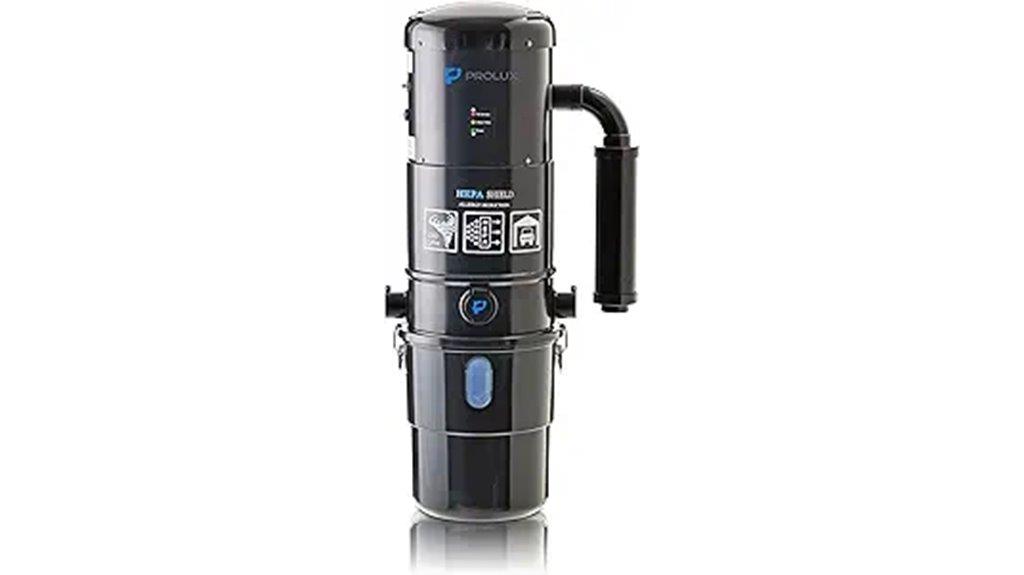
The Prolux CV12000 Central Vacuum Cleaner Power Unit stands out for its quiet operation, making it an ideal choice for homeowners who prioritize a peaceful indoor environment without sacrificing cleaning power. Its powerful 2-stage Amtek motor delivers over 130 CFM airflow, ensuring efficient cleaning for homes up to 12,000 sq ft. The external muffler and bypass system enhance durability and reduce noise, while the bagless design with washable filters improves air quality by removing dirt and allergens. Constructed with durable powder-coated steel, it also features a garage vacuum port for added convenience. Overall, this unit combines silent operation with robust performance, making it a top option for quiet, effective cleaning.
Best For: homeowners seeking a quiet, high-performance central vacuum system suitable for large homes up to 12,000 sq ft.
Pros:
- Operates quietly thanks to external muffler and bypass system.
- Powerful 2-stage Amtek motor delivers over 130 CFM airflow for efficient cleaning.
- Durable construction with powder-coated steel and washable filters that improve air quality.
Cons:
- Non-Prolux branded filters or accessories may void the warranty.
- Requires separate purchase of additional hoses and accessories for full functionality.
- Heavier construction may be less portable compared to handheld vacuums.
OVO Heavy Duty Central Vacuum System with Accessories
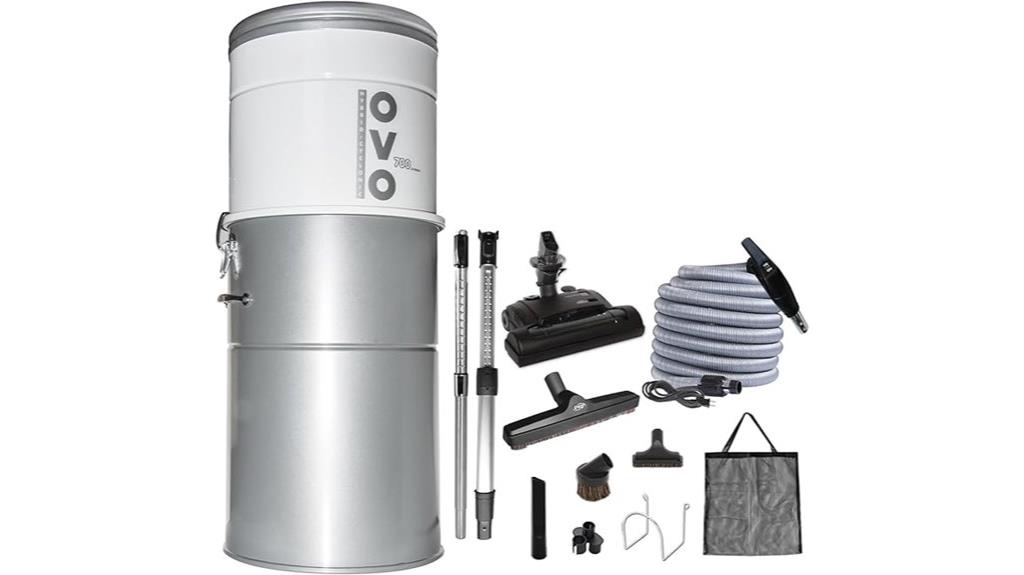
Designed for large homes up to 9,000 square feet, the OVO Heavy Duty Central Vacuum System offers powerful cleaning with minimal noise, making it ideal for those who value quiet operation without sacrificing suction strength. It features a 700 Air Watts motor with soft start-stop technology, extending its lifespan by 20%. The system includes hybrid filtration, allowing use with or without disposable bags, and a washable filter for easy maintenance. With a 35-liter capacity and a 35-foot hose, it handles extensive cleaning tasks. Its muffler and foam insulation keep noise levels at just 70 dB, ensuring a peaceful environment while delivering exceptional performance.
Best For: homeowners with large properties up to 9,000 sq ft seeking powerful, quiet, and easy-to-maintain central vacuum cleaning solutions.
Pros:
- Powerful 700 Air Watts motor with soft start-stop technology for extended motor life
- Hybrid filtration system allowing use with or without disposable bags for versatile maintenance
- Quiet operation at only 70 dB, ideal for noise-sensitive environments
Cons:
- Assembly required, which may be time-consuming for some users
- Heavier weight of approximately 50.9 pounds could be challenging to handle during installation or maintenance
- Customer reviews average 3.8 out of 5 stars, indicating some users may experience issues or dissatisfaction
Prolux CV12000 Central Vacuum Cleaner with Tools and Hose
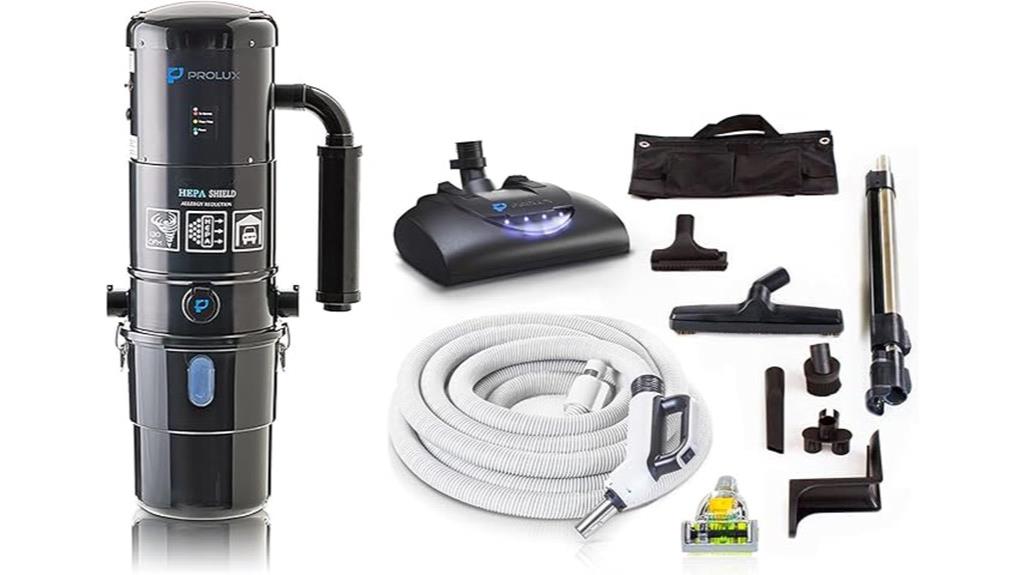
For those seeking a powerful yet quiet cleaning solution, the Prolux CV12000 Central Vacuum Cleaner stands out with its external muffler that markedly reduces noise during operation. Its durable powder-coated steel design ensures long-lasting performance, while the Amtek 2-stage motor delivers over 130 CFM airflow for strong suction. The bagless filtration system, including washable filters and a dirt chamber, maintains peak performance and air quality. It’s easy to install in homes with existing piping, and the 30-foot hose, tools, and accessories make cleaning versatile. The external muffler can be removed for blowing or inflating tasks, offering added convenience and silence.
Best For: homeowners seeking a powerful, quiet, and durable central vacuum system with versatile cleaning options and air filtration.
Pros:
- Powerful suction with over 130 CFM airflow thanks to the Amtek 2-stage motor
- Reduced noise operation due to the external muffler, enhancing comfort during use
- Durable powder-coated steel construction for long-lasting performance
Cons:
- Warranty is void if non-Prolux filters or accessories are used
- Requires existing central vacuum piping for installation, limiting portability
- External muffler, while reducing noise, may need removal for certain tasks like blowing or inflating
OVO Central Vacuum System, 700 Airwatts, 6.6 Gal Canister
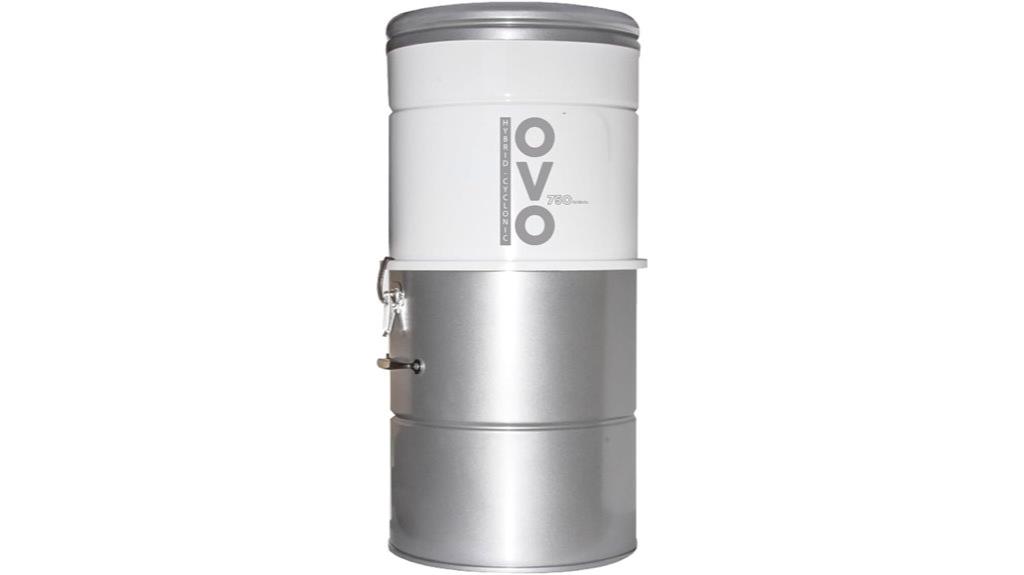
Are you looking for a powerful yet quiet vacuuming solution for large spaces? The OVO Central Vacuum System offers just that. With 700 Airwatts and a 5.7″ two-stage motor, it delivers impressive airflow of 140.2 CFM, making it ideal for up to 7,500 sq.ft. of coverage. Its hybrid filtration system, including disposable bags and a washable filter, ensures cleaner air. The 6.6-gallon canister provides ample capacity, and the silent operation is enhanced by an integrated muffler and noise-blocking foam. Weighing only 27.2 pounds, it’s designed for durability and efficiency, perfect for thorough home cleaning without the noise.
Best For: homeowners and cleaning professionals seeking a powerful, quiet, and large-capacity central vacuum system for extensive indoor spaces up to 7,500 sq.ft.
Pros:
- High airflow of 140.2 CFM and 700 Airwatts for thorough cleaning performance
- Quiet operation with integrated muffler and noise-blocking foam
- Large 6.6-gallon canister capacity suitable for extensive cleaning tasks
Cons:
- Heavy at 27.2 pounds, which may require effort to install or move
- Indoor use only, limiting versatility for outdoor cleaning
- No batteries needed, so it requires a wired setup and permanent installation
Factors to Consider When Choosing Quietest Central Vacuum Systems for Homes
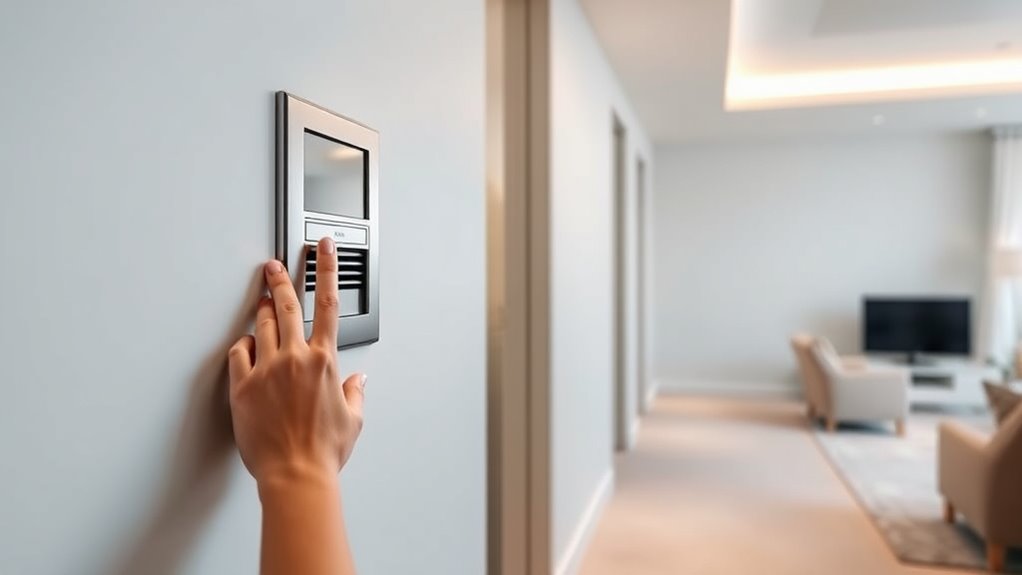
When choosing a quiet central vacuum system, I look at noise level ratings and motor technology to guarantee minimal disturbance. I also consider sound insulation features and filtration efficiency to keep the environment comfortable and clean. Additionally, canister capacity size matters for convenience and long-term use.
Noise Level Ratings
Choosing a quiet central vacuum system starts with paying attention to its noise level ratings, typically measured in decibels (dB). Generally, quieter models operate below 70 dB, making them ideal for noise-sensitive households. Many silent systems incorporate mufflers and soundproof foam insulation to cut down noise during operation. A lower dB rating means less sound, which is vital if you have children or prefer a peaceful environment. Some models feature noise-reducing technologies like soft start/stop motors that minimize sound fluctuations when turning on or off. Comparing decibel ratings across different models helps identify which will produce the least noise during use. Ultimately, paying attention to these ratings guarantees you select a system that maintains a quiet, unobtrusive cleaning experience.
Motor Technology Type
Motor technology plays a vital role in determining how quietly a central vacuum system operates. Two-stage motors, for example, tend to produce less noise than single-stage ones because they run more efficiently and smoothly. Brushless motors are another excellent choice, as they generate less mechanical noise compared to brushed motors, making them noticeably quieter. Modern motors often incorporate soft start-stop technology, which reduces sudden noise spikes during operation, creating a more peaceful experience. Hybrid or bypass designs help minimize vibration and strain, further lowering noise levels. Additionally, high-efficiency motors with advanced noise-dampening features, like sound-absorbing materials and mufflers, considerably enhance quietness. Choosing the right motor technology is essential for a system that’s both powerful and whisper-quiet.
Sound Insulation Features
Sound insulation features are essential for minimizing noise in central vacuum systems, especially if you want a quieter home environment. Components like mufflers and foam insulation can markedly cut down noise levels, with built-in mufflers reducing sound by up to 50%. Acoustic materials, such as sound-dampening foam, are often placed inside the motor chamber to absorb vibrations and dampen sound. Enclosing the motor and internal parts with soundproof housings further lowers operational noise. Proper placement of the system away from main living areas and the use of noise-blocking barriers can also make a noticeable difference. These sound insulation features work together to ensure your vacuum runs quietly, enhancing comfort without sacrificing power or efficiency. When choosing a system, prioritize those with advanced soundproofing options for the quietest operation.
Filtration System Efficiency
A key factor in guaranteeing your central vacuum system operates quietly is its filtration setup. High-efficiency filters like HEPA can trap 99.97% of particles, boosting indoor air quality without adding noise. Hybrid filtration options give you the flexibility to choose between disposable bags and bagless filters, which helps optimize airflow and debris containment, reducing operational sounds. Washable and permanent filters also contribute to consistent noise levels since they don’t require frequent replacements. Proper sealing and insulation around filters and canisters further minimize sound leakage. Additionally, incorporating mufflers, foam insulation, and noise-blocking materials into the filtration design can considerably cut down on operational noise. Choosing a system with efficient filtration not only keeps your home cleaner but also guarantees quieter, more comfortable vacuuming.
Canister Capacity Size
Choosing the right canister capacity is essential for maintaining quiet operation in a central vacuum system, especially in larger homes. Larger canisters, like 35 liters or more, are perfect for extensive cleaning sessions, reducing how often you need to empty them. This not only minimizes interruptions but also keeps noise levels low during maintenance. Bigger tanks are usually made from durable materials like steel, supporting heavy-duty cleaning while preserving quietness. Keep in mind, a larger canister increases the overall system size and may affect installation requirements. Proper insulation and robust design help contain noise, making larger capacity systems ideal for those prioritizing quiet operation. Ultimately, selecting the right canister size balances convenience, efficiency, and noise reduction in your home.
Installation Complexity Level
When selecting a central vacuum system for quiet operation, understanding the installation complexity is essential. The type of piping—PVC, metal, or flexible hoses—affects how straightforward the setup will be. In-wall or in-ceiling systems often require professional installation, which can increase both time and cost. Some models feature quick-connect or snap-in fittings, making installation easier and reducing the need for specialized tools or skills. The number and placement of inlets also influence difficulty, especially when retrofitting existing homes. Additionally, compatibility with your current infrastructure matters; systems that need electrical wiring or circuit modifications can add to the complexity. Overall, evaluating these factors helps guarantee you choose a system that fits your home’s layout and your installation preferences.
Power and Airflow
Ever wondered what makes a central vacuum system both quiet and effective? It all comes down to power and airflow. Higher airflow, measured in CFM, means stronger suction and better cleaning. A motor with a soft start-stop feature also helps, gradually increasing and decreasing power to reduce noise. Surprisingly, lower horsepower motors paired with adequate airflow can deliver quiet operation without sacrificing performance. Noise levels at or below 70 decibels are typical for quiet systems, making them less disruptive. Proper insulation, mufflers, and foam padding around the motor and canister further cut down operational noise. Balancing airflow and thoughtful design ensures you get powerful cleaning with minimal sound, making your home both spotless and peaceful.
Price and Warranty Options
Selecting a quiet central vacuum system involves more than just evaluating power and airflow; it also means considering the value and protection you get from your investment. I recommend checking the warranty length and coverage, as longer warranties often reflect manufacturer confidence in durability. Be sure to review any exclusions, especially for non-branded parts or accessories, which could void your coverage. It’s smart to compare the initial cost with what the warranty offers—sometimes a higher-priced system provides better long-term value through extensive support. Look for warranties that include technical assistance or service, so you’re covered if issues arise. Keep in mind, more expensive models may come with better warranty terms, but always verify the specific conditions to ensure you’re making a well-informed decision.
Frequently Asked Questions
How Do Noise Levels Vary Among Different Central Vacuum Models?
Noise levels vary quite a bit among central vacuum models. Some are designed with advanced soundproofing, making them whisper-quiet, while others produce more noise due to their motor size or construction. I’ve found that models with insulated motors and noise reduction features tend to be much quieter and more pleasant to use. If you want a peaceful experience, look for systems specifically marketed as low-noise or silent.
What Maintenance Practices Help Keep Vacuum Noise to a Minimum?
Think of your vacuum as a finely tuned instrument; regular maintenance keeps it singing softly. I check filters monthly, replace worn belts, and clear out the hoses to prevent blockages. Lubricating moving parts also helps reduce noise. By treating my vacuum like a delicate orchestra, I guarantee it performs quietly and efficiently, giving me peace of mind and a cleaner home without the disruptive hum.
Are There Specific Features That Contribute to Quieter Operation?
Yes, there are specific features that make a vacuum quieter. I look for systems with sound-dampening insulation, noise-reducing motors, and vibration-absorbing mounts. Additionally, models with smoother airflow paths and sound-absorbing filters help minimize noise. When I chose my system, I prioritized these features, and the difference in quiet operation was noticeable. It’s amazing how thoughtful design can make vacuuming much more pleasant.
How Does Room Size Impact Vacuum Noise Levels in Homes?
You might think room size doesn’t matter, but it definitely does. Larger rooms tend to amplify noise because the vacuum’s sound waves bounce around more, making it seem louder. Smaller spaces can contain the sound better, so the vacuum feels quieter. I’ve found that choosing a system with soundproofing features and proper ducting helps keep noise levels manageable, regardless of room size.
Can Soundproofing Accessories Further Reduce System Noise?
Yes, soundproofing accessories can definitely help reduce system noise. I’ve found that adding insulation around the vacuum’s motor compartment or installing mufflers on the exhaust can make a noticeable difference. These accessories trap and dampen sound vibrations, creating a quieter environment. While they won’t eliminate all noise, they’re a smart upgrade if you want a more peaceful cleaning experience without sacrificing power or efficiency.
Conclusion
If you want a vacuum so silent, it’s like whispering to your walls while cleaning, these are your top picks for 2025. Imagine powering through your home with a system so quiet, it’s practically a secret agent—silent but deadly efficient! Don’t settle for noisy chaos; embrace the peace and power these unbeatable systems offer. Trust me, once you go quiet, you’ll wonder how you ever cleaned loud.
